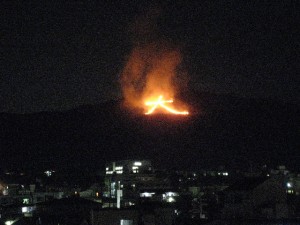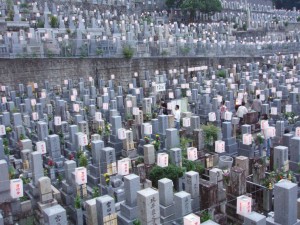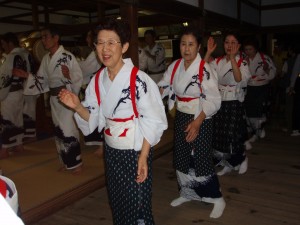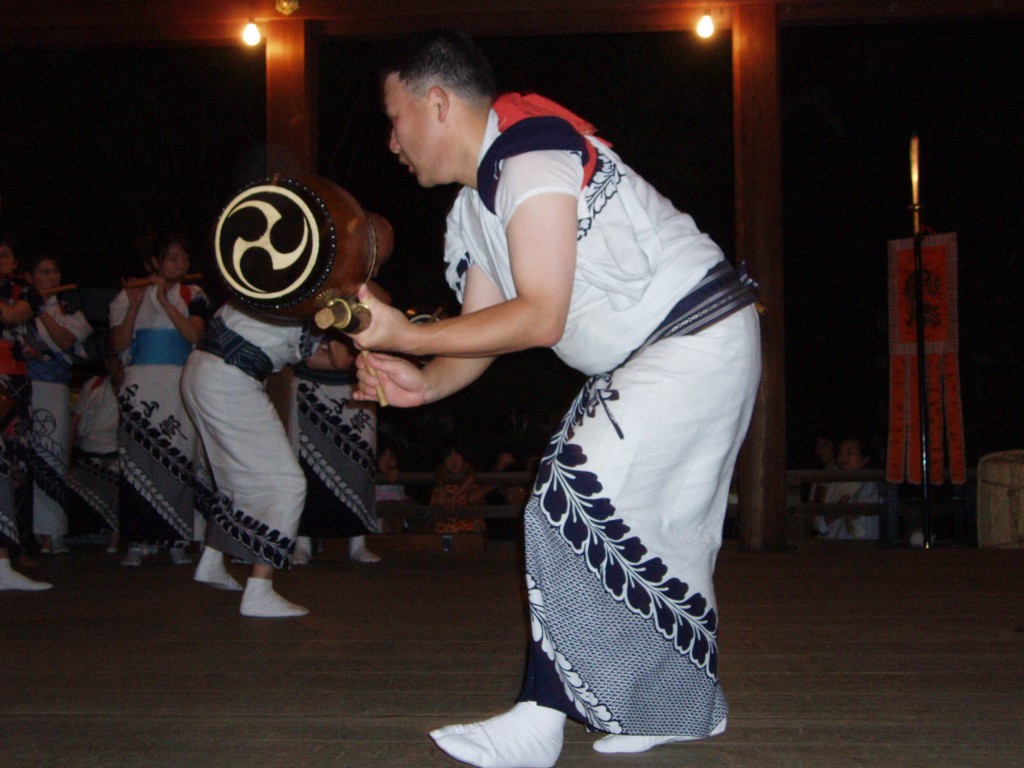It’s the last day of Obon, and the spirits of the dead are preparing to leave Kyoto on their journey back to the otherworld. What is it with Japanese and spirits? Ghostly figures haunt their imagination, and Noh is filled with restless souls. From The Tale of Genji to offerings at the family altar, the dead are ever present.

Daimonji fire seen from my bedroom
Here in Kyoto it’s the day of Daimonji when the surrounding hills are lit up with five different emblems to guide the dead spirits back from where they came. Two of the hills show the kanji for ‘big’ to signify the Great Teaching of Buddhism; one contains the characters ‘myoho’ to signify Glory to the Great Law; another is a ship to ferry the souls back home; and the last is a torii, as if a gateway to another world.
Daimonji offers a great example of how syncretic Shinto-Buddhism remains the default mindset, despite the artificial separation of Meiji times. Personally I think one could go even further and say that ancestor worship is the country’s real faith. ‘Ancestor worship has been the main current in forming Japanese religion,’ writes Doi Masatoshi in his study of ‘Religion and the Social Structure of Japan’.
As has often been said, the term is a misnomer. You don’t worship ancestors in the sense you worship God. And it’s not really about ancestors, so much as one’s immediate family. You talk to them, cherish their memory and try to ensure they have a comfortable afterlife. You put out their favourite food and drink at graves and places of remembrance. You treat them in short as if they were still living, which in a sense they are. They’re alive in the heart of those who survive them.

Lanterns at graveyards welcome the dead back
Since Shinto’s concern is with this world, the afterlife is traditionally given over to Buddhism. Memory of the dead is cultivated at a Buddhist altar, with food set out for the deceased and announcements made to them of important family events. The dead become hotokesama (buddhas), though in the Shinto view of things they also become kami after their death, first as an individual and then merging into an ocean of kamihood. In some regions it was customary to move the ihai (mortuary tablet) from the Buddhist altar to the kami shelf to signify the transition. The dead thus become kamisama and hotokesama. Even after death Japanese cling to their syncretism!

Bon odori: dancing with the dead
Psychologists have suggested there are benefits to ancestor worship, and researchers at the University of Graz in Austria found that thinking of the hardships overcome by previous generations helped boost performance in exams and interviews. It provides too consolation for the heart-rending sense of finality that death brings. Filmmaker Koreeda Hirokazu (director of Afterlife) claimed that ‘even after my father’s death I was able to continue to develop my relationship with him.‘
There’s a moral dimension too, for the notion that one’s dead parents are watching provides a very real stimulus for moral rectitude because of a reluctance to face them with a guilty conscience. At the same time the practice cultivates a sense of gratitude, which is said to lie at the heart of Shinto and Japanese culture at large. No matter how bleak the circumstances, no matter how dark the future, one’s in possession of the miracle of life and one owes it to one’s ancestors. Arigatou gozaimasu!

Though Obon is associated with Buddhism, Shinto is involved too as can be seen here by this dancer with his triple tomoe drum at a shrine in Kyoto

John,
Great post, I especially enjoyed the reference to Koreeda’s film “Afterlife” which is one of my favorites. A few questions. One is about a reference to the Dai kanji during the sending off fire festival. You write that it means great law of Buddhism. There might be quite a few interpretations of those fires. One that is often told is that the Dai represents a person and by extension a spirit. The spirit is attracted to itself and starts its long journey back. The myo/ ho kanji makes sure they stay on the right path and also reminds those remaining to keep praying for our ancestors. The ship of course brings them a bit further, the left dai which forms almost a mirror image to the right one, further attracts the spirit onward. This may have a bit to do with the whole idea of mirrors having special powers for attracting Kami. Finally the gate in the west is the gate to the afterlife. The whole movement from east to west mirrors our journey to the Pure Land.
The second interesting point your post raises is this sentence– “You don’t worship ancestors in the sense you worship God” Worship is a very personal matter. If one includes prayer as part of worship then there seems to be a lot of similarity. The discussions one has with a dead family member can be quite similar to one that is had with whatever god one speaks to. “Grandma, please take care of me during this childbirth.”
Third and last point, is that the monopoly on the dead really took over during the Edo Period with the danka system. It seems before that “shinto” was quite involved in the rituals of death. What else was there really at one point? I use quotes because I am not sure we can call early kami worship Shinto. But the native religion surely must have dealt with death before the arrival of Buddhism and I would guess they still had a large part in it post the 6th century. As your post explains. the dead become kami after a time. Putting the dead up on the mountains and sending them into the Kami world sounds very Shinto. At any rate fine post on the rituals of the dead. The concepts of gratitude and respect are deeply ingrained and practiced during the several times in the year when the dead are respected.
Hi Paul, all of those are great points. Thanks very much for the feedback.
Here is some interesting Daimonji info from the internet: http://www.kyopro.kufs.ac.jp/dp/dp01.nsf/ecfa8fdd6a53a7fc4925700e00303ed8/39a25070c2c77b084925748e00270211!OpenDocument
Folk beliefs
1 Drink some sake or water with the reflection of Daimonji, and you won’t get a disease.
2 Charcoal from Okuribi hung on your front door keeps evil away from your family.
3 Drinking the charcoal powder of Okuribi mixed in water brings you good health.
4 It is said that ancestoral spirits come back to this world guided by “Daimonji,” then read a sutra at “Myo-Ho,”and finally ride the “Ship” to go through the “Torii-Gate.”
Not Okuribi, but. . .
Five mountains were lit when the Russian emperor visited Kyoto in 1891.
Also when Japan won wars in 1895 and 1903, delighted Kyoto citizens lit fires on Mt. Daimonji that meant “Celebrate Peace.”
On the other hand, they could not light the fire for three years because of the Pacific War. Instead, elementary-school students dressed in white clothes climbed the mountain and made a white “Dai” on the morning of August 16th.
On December 31st of 2000, the last day of the 20th century, five mountains were lit to welcome in the new century.
I too appreciated the Kore’eda reference. I have a similar feeling about my son. In life, he was my greatest teacher. In death, he became even bigger.